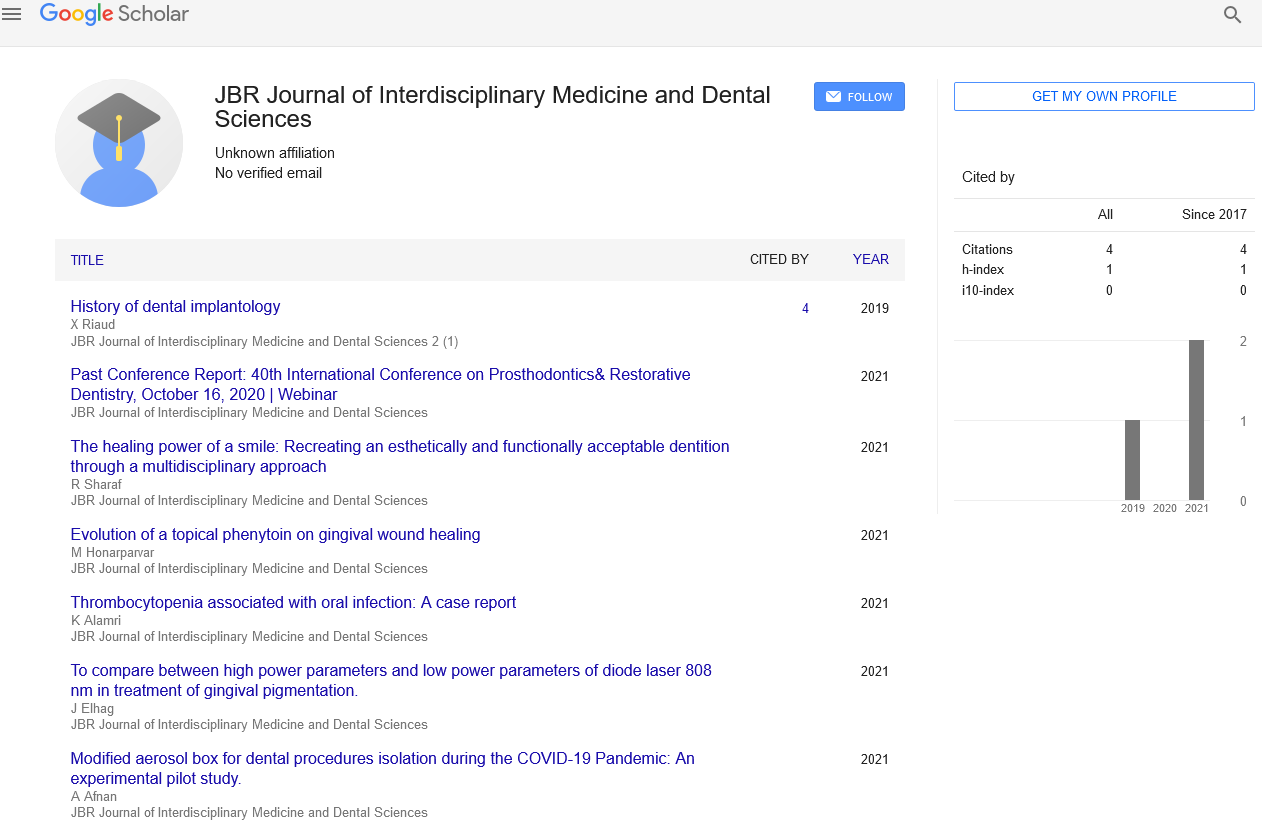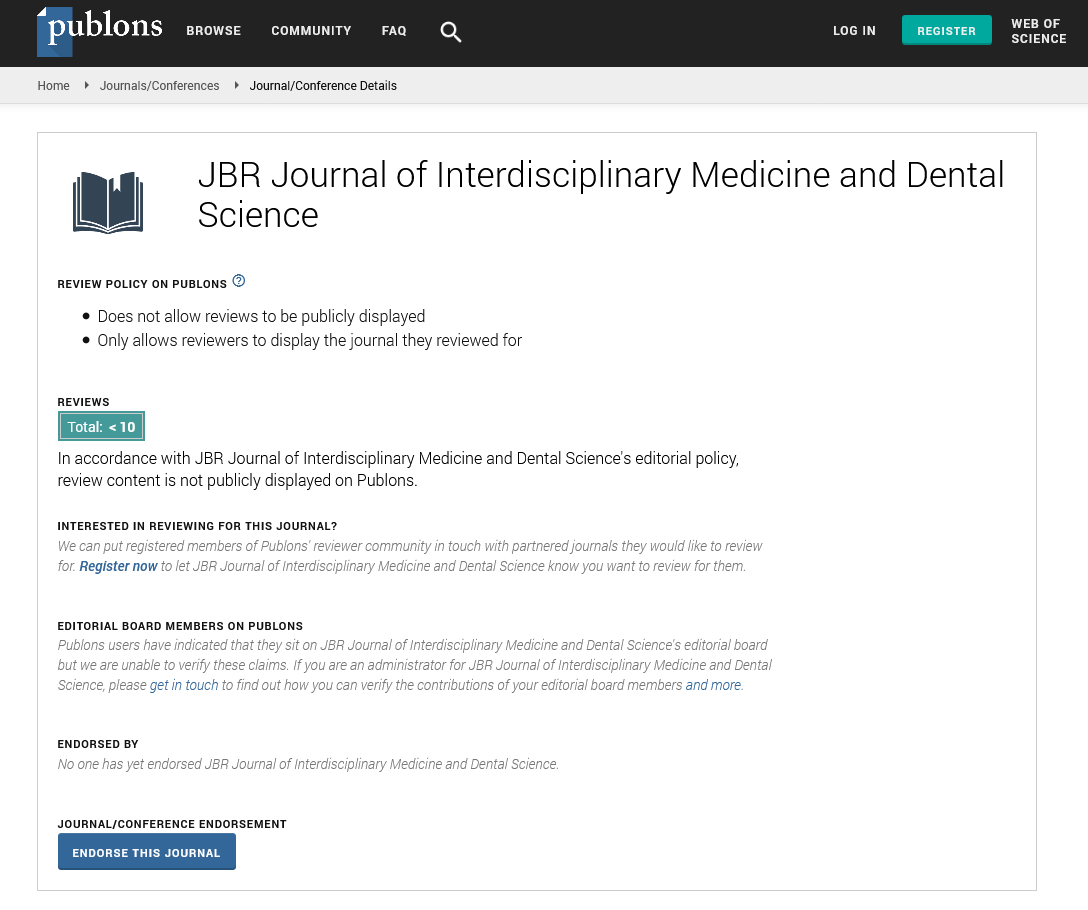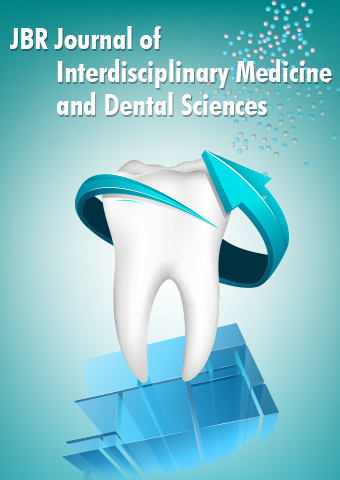Review Article - JBR Journal of Interdisciplinary Medicine and Dental Sciences (2023) Volume 6, Issue 1
Oral cancers
Charlie Wang*
Department of Surgery, Australia
Department of Surgery, Australia
E-mail: wangcharlie4545@rediff.com
Received: 02-Jan-2023, Manuscript No. JIMDS-23-85875; Editor assigned: 04-Jan-2023, PreQC No. JIMDS-23-85875(PQ); Reviewed: 18-Jan-2023, QC No. JIMDS-23-85875; Revised: 23-Jan-2023, Manuscript No. JIMDS-23-85875(R); Published: 30-Jan-2023, DOI: 10.37532/2376- 032X.2023.6(1).07-10
Abstract
Because each patient presents the treating doctors with a different set of issues, the care of oral cancer is a multidisciplinary endeavour that affects both survival and quality of life. The care of oral cancer is the main topic of this essay. We emphasise the epidemiology of oral cancer in Australia, its risk factors, the numerous clinical manifestations that might develop, and its staging. Surgery continues to be the basis of therapy in the great majority of patients. Oncology and radiation therapy are frequently utilised adjuvantly. From the early discovery to optimising pre-treatment oral health and managing the short- and long-term aftereffects of therapy, dental professionals play a key role in various stages of care. A crucial responsibility is to monitor for recurrence and the emergence of new primary tumours [1].
Introduction
An imagined coronal plane traced from the junction of the soft and hard palate, the circumvallate papillae of the tongue, and the vermillion of the lips is used to describe the oral cavity as the anatomical space between those points. To categorise oral cavity cancer, there are seven subsites in the mouth (lip, tongue, floor of mouth, buccal, hard palate, alveolar, retromolar trigone and soft palate).
One of the most prevalent cancers, particularly in underdeveloped nations but also in the industrialised world, is oral cavity cancer [2]. The most prevalent histology is squamous cell carcinoma (SCC), and cigarette and alcohol use are the primary etiological causes. Despite the simplicity of early detection, it is not unusual for patients to arrive with advanced illness. Primary surgical resection, with or without postoperative adjuvant treatment, is the gold standard of care [3]. Over the past ten years, new surgical procedures and standard postoperative radiation or chemoradiation therapy have led to higher survival rates. Multidisciplinary treatment plans that optimise oncologic control while minimising the impact of therapy on form and function are essential for the successful treatment of patients with oral cancer. Every patient with oral cancer poses a different set of difficult, intricate, and interdisciplinary clinical difficulties to the treating physician, the answers to which have an influence on the patient’s survival and quality of life [4]. All malignancies of the mouth should be treated by a multidisciplinary head and neck oncology team. The Head and Neck Multidisciplinary Team (H&N MDT) is made up of many different clinicians, including (but not limited to): oral and maxillofacial, ear, nose, and throat, and plastic & reconstructive surgeons; radiation oncologists; medical oncologists; radiologists; anatomical pathologists; anaesthetists; speech and language therapists; dieticians; head and neck nurses; physiotherapists; oral medicine specialists; prosthodontists [5].
Due to the functional and aesthetically detrimental effects of treating tumours in this area, the management of malignancies of the oral cavity is complicated. Breathing, speech, deglutition, sight, smell, taste, mastication, and jaw function are just a few of the crucial head and neck activities that might be negatively impacted by a tumour or its treatment, either temporarily or permanently. Self-esteem and self-confidence may be significantly impacted by the tumour itself and/or its treatment, in addition to how others view our face and oral appearances [6].
The detection of premalignant lesions, early detection of oral cancer, management of the patient’s dentition prior to and following definitive treatment, surveillance of recurrent or new primary tumours in collaboration with the treating specialist, and restoration of missing teeth in collaboration with the maxillofacial surgeon and prosthodontist all fall under the purview of dentistry [7].
Anatomy of the oral cavity
The oral cavity reaches from the vermilion border of the lips inferiorly to the junction of the hard and soft palate, and superiorly to the circumvallate papillae of the tongue. The lip, oral tongue, floor of the mouth, buccal mucosa, upper and lower gum, retromolar trigone, and hard palate are some of the anatomical subsites of the oral cavity. These subsites are close together, yet they each have unique anatomical traits that must be considered when developing an oncologic treatment strategy [8].
Epidemiology and etiology: There are expected to be 405,000 new cases of oral cancer worldwide each year, with Sri Lanka, India, Pakistan, Bangladesh, Hungary, and France having the highest rates. An estimated 66,650 new cases are reported in the European Union per year. According to the American Cancer Society, there will be 42,440 new cases of oral and pharyngeal cancer in the United States in 2014, resulting in 8,390 fatalities. The two primary etiological factors for SCC of the oral cavity are alcohol use and tobacco use (SCCOC). The Asian population has also been linked to other bad behaviours including chewing tobacco and betel nuts. Numerous cancer-causing chemicals, including polycyclic hydrocarbons and nitrosamines, are found in tobacco. The risk of SCCOC is inversely correlated with the number of packs of cigarettes consumed each year. After quitting smoking, this risk can be decreased, although it does not completely disappear (30% in the first 9 years and 50% for those over 9 years). In the past 15 years, there has been a documented drop in the incidence of oral cavity cancer, which is often related to a decline in cigarette usage [9]. Alcohol and tobacco appear to contribute in a complementary manner to the development of oral and oropharyngeal SCC. Even among nonsmokers, drinking is connected to a higher risk of cancer. Other variables have been identified as causative factors, including poor dental hygiene, exposure to wood dust, nutritional deficits, and eating of red meat and salted meat. Although hypothesised, the herpes simplex virus (HSV) has not been linked to the pathogenesis of SCCOC. Although there is growing evidence that the human papilloma virus (HPV) plays a part in the genesis of oropharyngeal cancer, SCCOC has not been definitively linked to HPV. An increased prevalence of head and neck cancer is linked to host variables such immune system changes in transplant patients, HIV-infected people with AIDS, and hereditary disorders like xeroderma pigmentosum, Fanconi anaemia, and ataxia telangiectasia. Men are more likely to get oral cancer, which often strikes after the fifth decade of life. A synchronous primary in the oral cavity or the aerodigestive tract will occur in around 1.5% of patients (larynx, oesophagus or lung). Regular post-therapy surveillance and modifying one’s lifestyle are crucial secondary preventive tactics since metachronous tumours tend to occur in 10% to 40% of cases within the first decade following treatment of the index main [10].
Pathology: Of all oral cancers, squamous cell carcinomas (SCC) account for more than 90%. Other malignant tumours can develop from melanocytes, lymphoid tissue, minor salivary glands, connective tissue, epithelium, and metastasizing from a distant tumour. SCC formation has been linked to several premalignant lesions. The probability for malignant development varies among the most prevalent premalignant lesions, such as leukoplakia, erythroplakia, oral lichen planus, and oral submucous fibrosis. Premalignant lesions are divided into four categories by the WHO (2005): mild, moderate, severe, and carcinoma in situ. A “white patch or plaque that cannot be classified clinically or pathologically as any other illness” is what the medical word leukoplakia refers to. Typically, drinking alcohol and smoking are linked to this lesion. About 2% of people globally have leukoplakia. Only 2-5% of patients experience dysplastic alterations. Leukoplakia has a 1% yearly malignant transformation rate. The existence of dysplasia, female gender, leukoplakia that has been present for a long time, position on the tongue or the floor of the mouth, leukoplakia in non-smokers, size more than 2 cm, and nonhomogeneous type are risk factors for malignant transformation. Excision is the only undisputed approach for precise diagnosis and therapy, in addition to lifestyle changes to avoid alcohol and cigarette use.
Bright red velvety patches known as erythroplakia are not produced by any other conditions, either clinically or pathologically. As these lesions are frequently linked to dysplasia and carcinoma in situ and have a higher malignant potential than leukoplakia, surgical removal is advised.
Oral cavity non-squamous cell carcinomas are rare. Less than 5% of malignancies of the oral cavity are minor carcinomas of the salivary glands. They often appear on the buccal mucosa (15%), lips (25%) and hard palate (60%) of the mouth.
The most prevalent kind is mucoepidermoid carcinoma (54%), which is followed by lowgrade adenocarcinoma (17%) and adenoid cystic carcinoma (15%).
Although they are uncommon, mucosal melanomas often manifest as locally aggressive tumours, primarily of the hard palate and gingiva. When present in the oral cavity, odontogenic tumours like ameloblastoma and bony tumours like osteosarcoma of the mandible or maxilla might be mistaken for mucosal lesions if there is surface ulceration.
Presentation and evaluation of clinical data
Despite simple physical and self-examination, individuals frequently have severe illness when they first appear. Patients with suspected oral cavity cancer must have a thorough head and neck examination. An accurate sense of the disease’s scope, a tumor’s third dimension, the existence of bone invasion, or skin disintegration can be obtained by visual inspection and palpation. The staging, decision-making, and subsequent follow-up of the tumour can all benefit from appropriate documentation with drawings and photographic evidence.
At the initial encounter, the clinical TNM stage should be noted, and it should be changed as the examination goes on. The first step of the procedure is a biopsy-based diagnostic. Utilizing punch forceps, a core needle, or fine-needle aspiration, accessible lesions can be effectively biopsied in the clinic. In order to reach posteriorly placed lesions or to finish a physical exam that is hindered by pain and trismus, some patients will need to have an examination while under general anaesthesia (EUA). Radiographic imaging is essential for determining the tumor’s relationship to the nearby bone and for evaluating the local lymph nodes. The preferred method for assessing bone and neck nodes is a CT scan, particularly for early cortical involvement and extra capsular nodal dissemination.
Because adult marrow is typically replaced by fat, MRI offers supplementary information regarding the degree of soft tissue and perineural invasion. It is also useful for assessing the extent of medullary bone involvement. The relevance of a PET scan in the first evaluation is disputed because the majority of oral cancer patients are not at risk for distant metastases. However, if adjuvant treatment is planned and a PET scan will be utilised for radiation therapy planning, a preoperative PET scan may be helpful as a baseline. The reconstructive surgeon, medical specialists for presurgical optimization, dental professionals, speech and swallowing pathologists, and behavioural therapists for smoking cessation and other lifestyle changes should all be consulted for patients with locally advanced malignancies.
The TNM system’s user-friendliness and relatively straightforward architecture make it the most extensively used prognostic system. Clinical staging for malignancies of the oral cavity considers the neck, the original tumour, and any potential distant metastases. TNM stage categorization for the tumour is made possible by this information. The size of the tumour and the infiltration of deep tissues are the fundamental factors in staging the main site. For T4a disease, invasion of structures like the masticator space, pterygoid plates, or skull base and/or encasing of the internal carotid artery are signs of advanced disease. For T4b disease, invasion of structures like the deep muscle of the tongue, maxillary sinus, and skin are signs of advanced disease. Typically, lymphatic expansion into the neck happens in an organised, predictable, and stepwise manner. The American Head and Neck Society Guidelines’ defined nomenclature is used to describe the neck’s lymph node tiers. The design of the neck dissection for patients with oral cancer might be affected practically by understanding the patterns of nodal metastases. The patient who has a clinically negative neck is most at risk for levels I–III metastases. Level IV skip metastases do happen, particularly in anterior tongue carcinoma. Even in individuals with clinically positive neck, metastatic disease reaching level V is exceedingly uncommon (1%). Of all oral malignancies, oral tongue tumours have the highest propensity to spread to the neck, and tumour thickness is a key indicator of the likelihood of nodal metastasis.
Diagnosis
Getting a biopsy sample of the lesion is necessary for the diagnosis of oral cancer. An oral and maxillofacial surgeon should ideally perform the biopsy because they have the chance to perform a full head and neck examination, including precise measurements, palpation of the lesion thickness, clinical examination of the cervical nodes, clinical photography, and in some circumstances, even obtain some imaging before the lesion is distorted by post-biopsy changes. This is particularly true for early oral cavity tumours when tissue oedema makes it challenging to detect the depth of the lesion on post-biopsy imaging. In general, incisional and excisional biopsies are the 2 types of biopsies that can be used. In virtually all circumstances, an incisional biopsy is preferred at the lesion’s edge where there is “normal” tissue, at a sufficient depth to allow the pathologist to evaluate tumour (SCC) penetration through the lamina propria. Other oral cancers, such as lymphoma, may require fresh tissue to be submitted for further testing in addition to histopathologic examination (biopsy in formalin) (e.g. flow cytometry). The histopathologic evaluation performed by an anatomic pathologist is essential in making the diagnosis of oral cancer. Given that different pathologists may interpret a biopsy differently, all maxillofacial surgeons who treat oral cancer will work closely with an anatomic pathologist who is knowledgeable on oral pathology. Additionally, if the clinical behaviour of the lesion does not match the “diagnosis” from the original biopsy, the treating surgeon will always maintain a low threshold for re-biopsy.
Once the tissue diagnosis has been made, the treating surgeon will schedule the necessary radiologic scans to radiologically stage the tumour, which involves determining the primary tumor’s dimensions and extent of invasion of surrounding structures, the involvement of the cervical nodes, and the presence of distant metastases. Computed tomography (CT), magnetic resonance imaging (MRI), ultrasound (US), and positron emission tomography (PET) are the imaging modalities frequently employed in oral cancer assessment. When evaluating the dentition or determining the height of the mandible in the event that a portion of the mandible needs to be removed owing to involvement with or closeness to malignancy, an orthopantomogram (OPG) is helpful.
Conclusion
Dentists and dental experts are essential to patient care at every stage since oral cavity cancer is a difficult illness with a high fatality rate. The dental professional plays a variety of roles in the management of oral cancer, including prevention through education about quitting smoking and responsible alcohol use, early detection and referral of premalignant lesions and oral cancers, ongoing surveillance, follow-up, and oral health preservation. All oral cancer patients should be treated by a multidisciplinary team with expertise in the treatment of head and neck tumours, and any worrisome lesions should be promptly referred to an oral and maxillofacial surgeon or an oral medicine specialist. Due to advancements in adjuvant therapy and reconstruction over the past few decades, treatment outcomes for individuals with oral cancer have significantly improved. Attrition from recurrent primary cancers in long-term survivors has hindered further advancements in survival. Improved knowledge and methods for early detection, as well as increased education about lifestyle-related risk factors, are necessary for both primary and secondary prevention of oral cancer.
References
- Cambon-Thomsen A, Rial-Sebbag E, Knoppers BM et al. Trends in ethical and legal frameworks for the use of human biobanks. J EUR R. 30, 373-382 (2007).
- Dietrich E, Powell J, Taylor JR et al. Canagliflozin: a novel treatment option for type 2 diabetes. Drug Des Devel Ther. 7, 1399-1408 (2013).
- Pratley RE, McCall T, Fleck PR et al. Alogliptin use in elderly people: a pooled analysis from phase 2 and 3 studies. Am Geriatr Soc. 57, 2011-2019 (2009)?
- Pratley RE, Rosenstock J, Pi-Sunyer FX et al. Management of type 2 diabetes in treatment-naive elderly patients: benefits and risks of vildagliptin monotherapy. Diabetes Care. 30, 3017-3022 (2007).
- Doucet J, Chacra A, Maheux Pet et al. Efficacy and safety of saxagliptin in older patients with type 2 diabetes mellitus. Curr Med Res Opin. 27, 863-869 (2011).
- Amori RE, Lau J, Pittas AG et al. Efficacy and safety of incretin therapy in type 2 diabetes: systematic review and meta-analysis. JAMA. 298, 194-206 (2007).
- Cvetković RS, Plosker GL. Exenatide: a review of its use in patients with type 2 diabetes mellitus (as an adjunct to metformin and/or a sulfonylurea). Drugs. 67, 935-954 (2007).
- Gallwitz B. Exenatide in type 2 diabetes: treatment effects in clinical studies and animal study data. Int J Clin Pract. 60, 1654-1661 (2006).
- Briones M, Bajaj M. Exenatide: a GLP-1 receptor agonist as novel therapy for Type 2 diabetes mellitus. Expert Opin Pharmacother. 7, 1055-1064 (2006).
- Verdonck LF, Sangster B, van Heijst AN et al. Buformin concentrations in a case of fatal lactic acidosis. Diabetologia. 20, 45-46 (1981).
Indexed at, Google Scholar, Crossref
Indexed at, Google Scholar, Crossref
Indexed at, Google Scholar, Cross Ref
Indexed at, Google Scholar, Crossref
Indexed at, Google Scholar, Crossref
Indexed at, Google Scholar, Crossref
Indexed at, Google Scholar, Crossref
Indexed at, Google Scholar, Cross Ref
Indexed at, Google Scholar, Crossref


